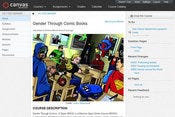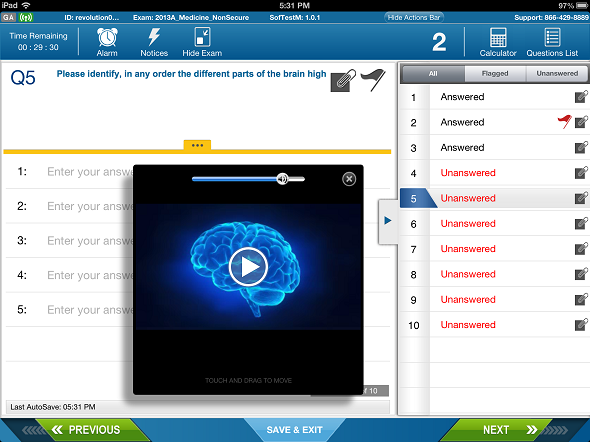iPad Exam App Takes Testing Offline
ExamSoft app not only makes the Web off limits, it creates new possibilities, such as med school tests in the morgue.


Inside Eight Game-changing MOOCs
Inside Eight Game-changing MOOCs(click image for larger view and for slideshow)
The Ohio State University College of Medicine has been doing computerized testing since 2002, but this year an iPad app is allowing the technology to go where it's never gone before: into a room full of dead people.
Eric Ermie, program manager for assessment and evaluation at the Ohio State University College of Medicine, said the SofTest-M app from ExamSoft worked well enough in testing this year that next year it will be employed much more extensively. "Next year, we will be giving an iPad to every single student when they walk in door," he said, partly so they can be tested this way. The devices will be purchased for first-year students and second-year students who don't already have one. The plan is that as students move into the third and fourth years of the program, they will swap their full-size iPads out for iPad Minis, which have been deemed more appropriate for their use once they move out of the classroom into hospital-based training.
The SofTest-M iPad app is designed to provide the security and reliability required for high-stakes exams, operating offline so that it is not dependent on a network connection, while blocking access to the Web and to reference materials or notes on the device for the duration of a test. The recently released iPad app joins ExamSoft clients for Windows and Macs, all of which work with a common Web-based administration system for test setup and analytics. Medical schools are a strong market for the company, along with law schools and some professional testing programs.
[ Take a tour of education technology from its humble beginnings to electronic tablets: Tablets Rock On: Education Tech Through The Ages. ]
Ohio State University College of Medicine switched to using ExamSoft on laptops about four years ago, replacing another computerized testing program that proved unreliable, sometimes failing just as the testing was completed, Ermie said. Although he can't endorse products, he said having the software available on the iPad made a significant difference. Over the course of this year, the medical school has experimented with using the iPads for testing, originally using a pre-release version of the software and only for relatively low-stakes quizzes. By the end of the year, the iPad app was judged trustworthy enough to be used for 150-question final exams.
Then the program started branching out, exploring scenarios that only make sense with the greater mobility of an iPad, such as practical anatomy exams carried out in a room full of cadavers. In this mode of testing, students walk from station to station around the room examining bodies, where the challenge is to identify the particular organ marked with a pin or answer questions about it. Medical students traditionally have provided paper-and-pencil answers to these questions, which sometimes turned grading into a handwriting analysis exercise -- perhaps proving what they say about doctor's handwriting.
With an iPad in hand, students were able to provide more precise answers to each prompt, Ermie said. The iPad also could be used to present information such as X-ray images to go along with the in-person examination of a cadaver.

SofTest-M iPad app
SofTest-M exams can include videos to illustrate a question or concept.
What the iPad adds is "flexibility and versatility," Ermie said. "The anatomy example is a huge one, but it's kind of the tip of the iceberg. This opens up possibilities for doing vetted, solid high-stakes assessment in a multitude of arenas where we weren't able to before." Another important element of the ExamSoft platform is the analytics it provides to make it easier for instructors to see patterns in the topics individual students are struggling with, Ermie said. "That's kind of amped up our usage and changed our intentions for what the software was good for," leading to an increased emphasis on measuring student performance "in more different ways, more frequently" to help them develop into competent physicians, he said.
Although the cadaver exam is a colorful example, the more typical scenario for ExamSoft testing, whether on the iPad or a laptop, is for proctored testing in a classroom or at a test center. Students are often encouraged to download the exam in advance, so as to avoid overloading the network with everyone downloading it at once. The file is encrypted, preventing them from starting or viewing an exam until the proctor gives the code to unlock it. In the case of a timed test, unlocking the test also starts the timer. When the test is complete, the app packages up the student's answers and sends them back to the test server.
This mode of delivery means the computerized tests are not "online" in the sense of requiring continuous network access and won't be interrupted by a glitch in a school building's Internet access. ExamSoft VP of business development Jason Gad said that's often the hardest part of his sales pitch, given that people have become so used to thinking of all interactive applications being Web-based. Skeptics are often halfway through explaining that Web-based testing won't work for their purposes when he finally gets his point across. "You can almost hear the sigh," he said, when they realize network access won't be an obstacle after all.
In fact, it's possible to give these examinations in locations with no wireless network access as long as students remember to download the exam in advance and upload the results afterward from home or the nearest Starbucks.
Instructors create tests through the ExamSoft Web application, which lets them enter a "question bank" of questions they can assemble and reorder for each test they give. Questions can include images, such as diagnostic imagery for medical students to evaluate; video; or PDFs. Including a lot of multimedia will also include the size of the download file for an exam. The ExamSoft software also helps instructors balance out their tests using Bloom's Taxonomy to determine whether they have the right mix of different types of questions, such as those requiring straight recall of facts versus others requiring synthesis of information.
Simply by checking a box, an instructor can require that the test be delivered in secure mode, which locks down the iPad or laptop to display just the testing application, with network access and access to other applications disabled. It's also possible to use the software for an open-book test, which might still be timed but allow students to search the Web and other resources to their heart's content. About 96% of the time, instructors choose the locked-down mode, Gad said, although that's starting to change as more instructors begin to use the software for early, proactive assessments rather than only for exams.
Follow David F. Carr at @davidfcarr or Google+, along with @IWKEducation.
About the Author
You May Also Like






